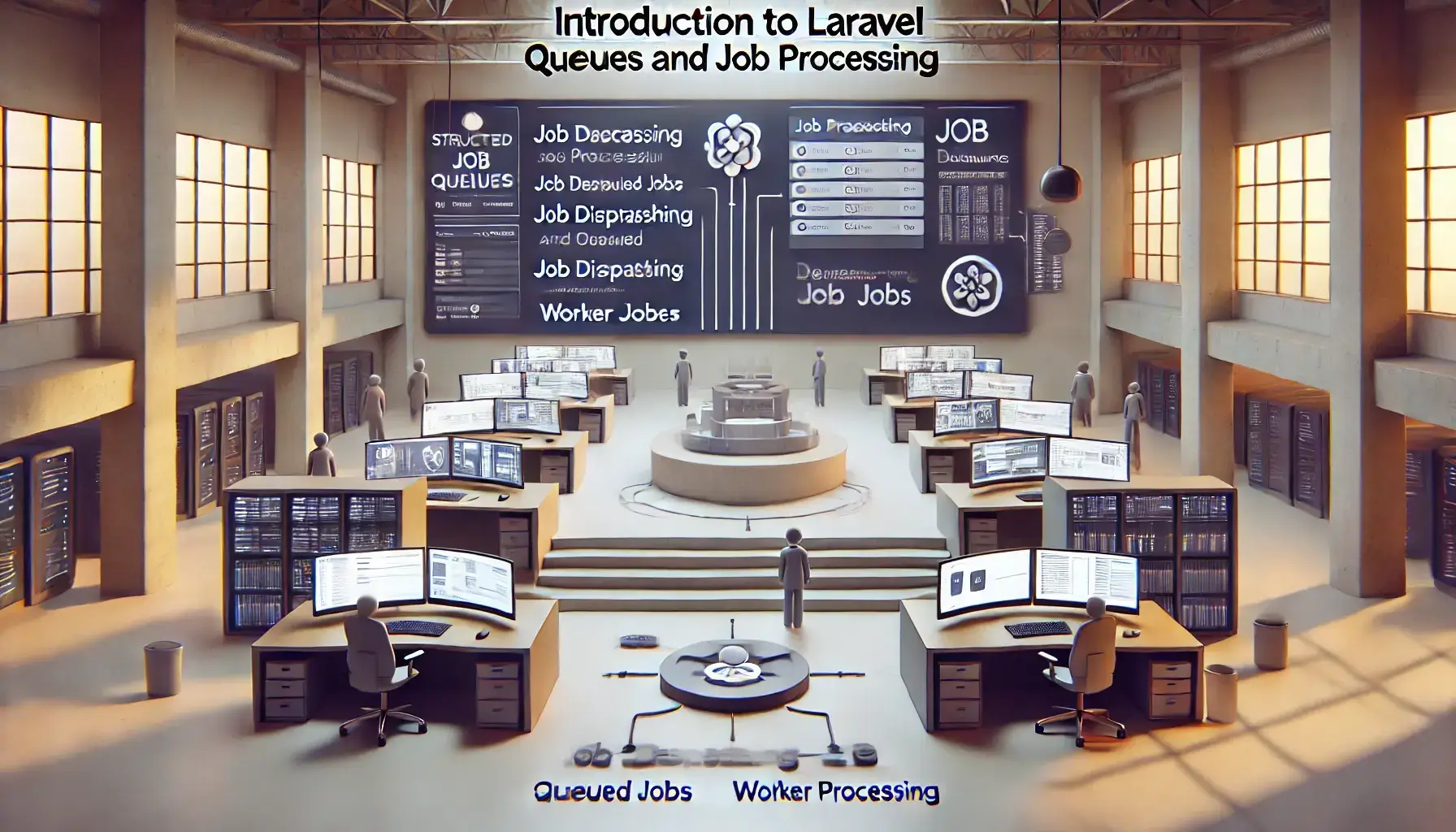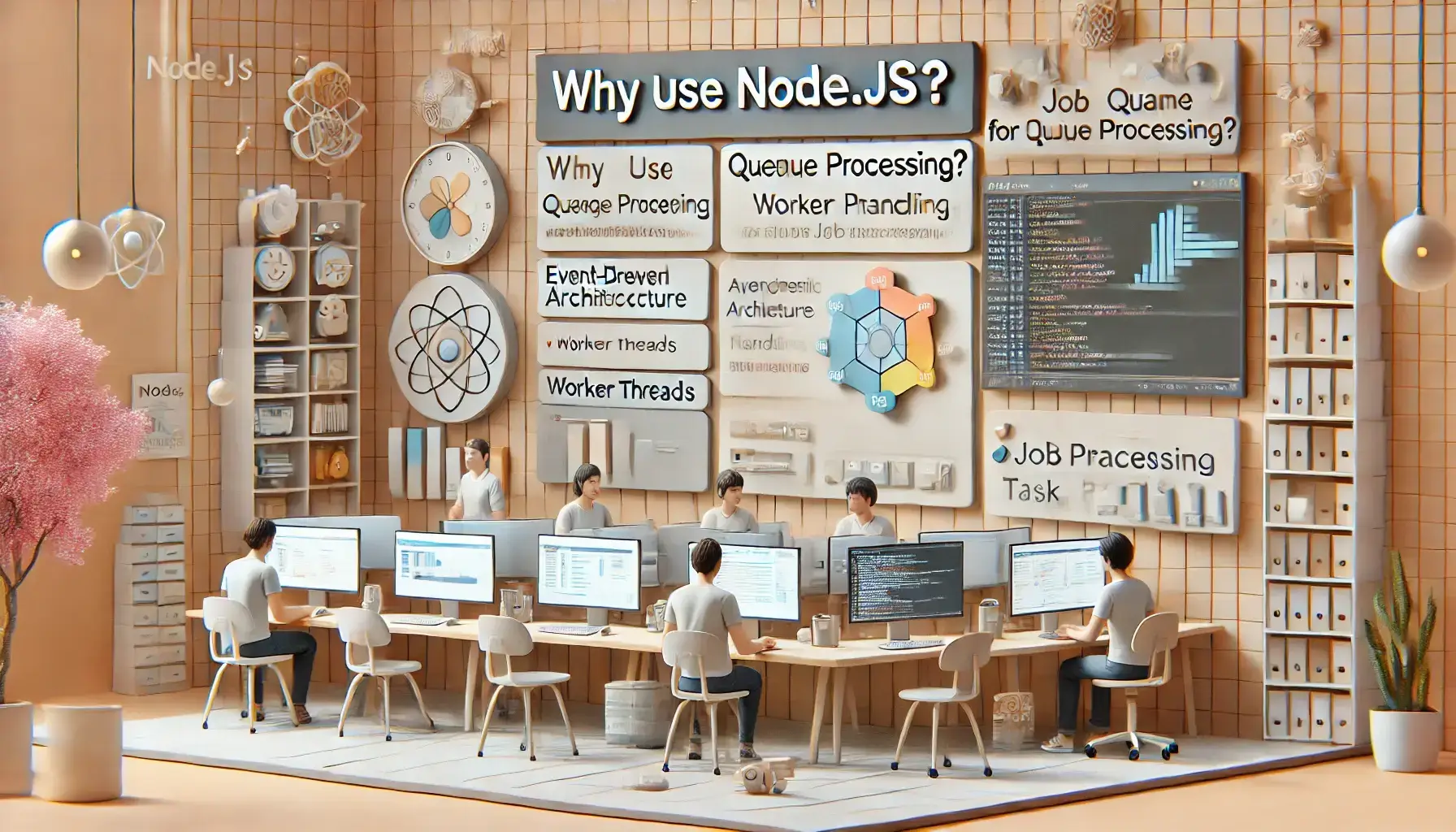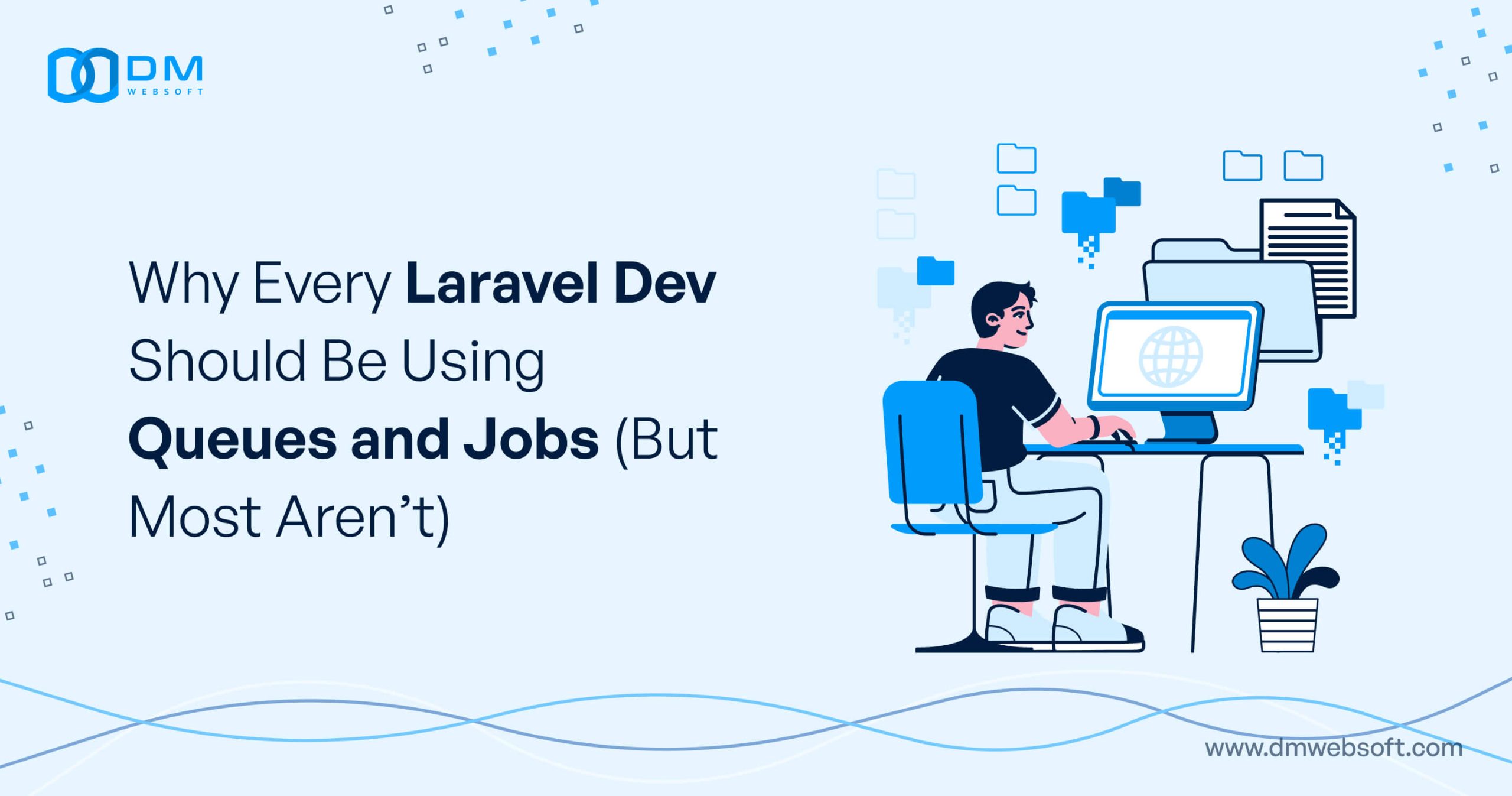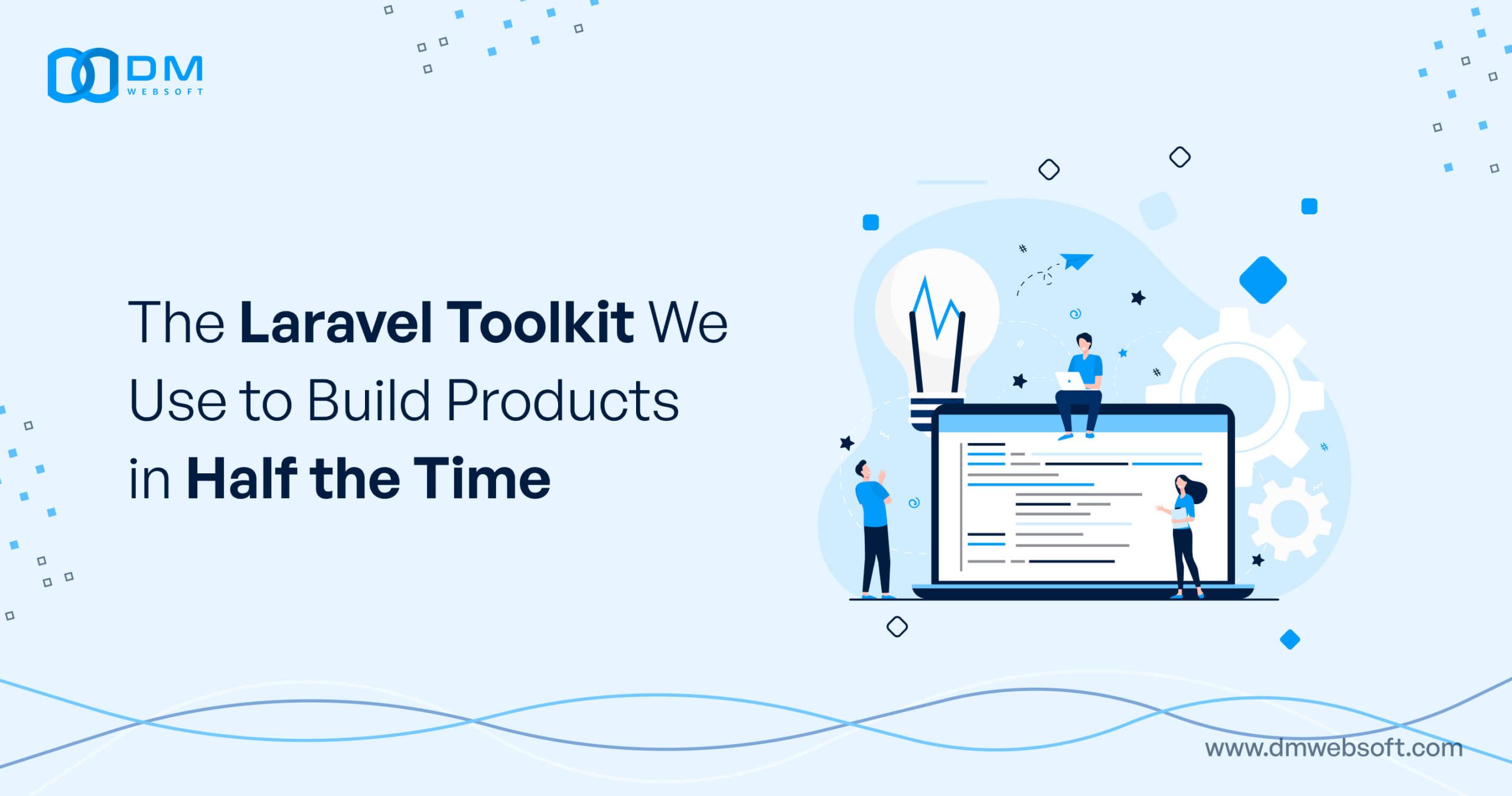DM WebSoft LLP exceeded our expectations! Their seasoned team of experts delivered a website that perfectly captures our brand essence. Their 15+ years of experience truly shine through in their exceptional web development skills.
Node.js + Laravel Queue: Building a Scalable Job Processing System

TABLE OF CONTENT
Introduction
Understanding Laravel Queues and Job Processing
Why Use Node.js for Queue Processing?
Building a Scalable Job Processing System with Node.js and Laravel Queues
Optimizing Job Processing for High-Performance Applications
Real-World Use Cases: How Businesses Leverage Node.js and Laravel Queues for Scalable Job Processing
Advanced Queue Management Strategies for High-Performance Applications
Optimizing Resource Utilization in Large-Scale Job Processing Systems
Monitoring and Debugging Job Processing Systems for Maximum Reliability
Conclusion
Get in Touch
Introduction

In contemporary web applications, job processing with high efficiency is essential in providing smooth performance, scalability, and responsiveness. Background jobs play an important part in big data processing, like email notification, data importing, image processing, and API integrations. Laravel Queues with Node.js provide a high-efficiency, scalable approach to execute asynchronous jobs in the best possible way.
Through the combination of the two technologies, developers can develop a high-performance system that runs jobs in the background, relieving the load on the main application and delivering better user experience.
Laravel, being a well-known PHP framework, features an in-built queue system with several drivers such as database, Redis, and Amazon SQS.
This feature enables applications to queue resource-intensive operations, thereby increasing response rates and preventing any interruptions in execution. Node.js, with its event-driven and non-blocking I/O capabilities, is best suited for the purpose of handling high-performance job queues.
Together, Laravel sends off the job and Node.js runs queued jobs asynchronously, making the system highly efficient and scalable, creating a scalable job processing system involves paying close attention to a number of factors such as queue setups, worker handling, error handling, and monitoring of the system. This post discusses how Laravel Queues and Node.js interact to build a system that can process thousands of background jobs with ease, while maintaining high availability and reliability in production.
Understanding Laravel Queues and Job Processing

Laravel has a powerful queue system that enables applications to run tasks that take a long time asynchronously. This helps the application not to lag by delegating time-consuming operations to a queue worker. The queue system is able to work with various queue drivers, such as the database, Redis, Beanstalkd, and Amazon SQS, so developers can choose the best storage mechanism according to their requirements.
When a task is dispatched in Laravel, it is added to a queue and held temporarily until a worker claims it for running. Laravel comes with a queue worker command that listens for incoming jobs and executes them asynchronously. This keeps the main application thread free, servicing incoming user requests without interruption. Laravel’s queue system also offers retry logic, failure handling, and job priority, enabling developers to handle background tasks effectively.
To use a Laravel queue system, the application should have a job class that encapsulates the background task’s logic. The job is then sent using Laravel’s queue system and waits to be run by a worker. The queue worker constantly listens for new jobs and runs them based on the set queue priority.
One of the primary benefits of Laravel queues is enhanced application performance. Time-consuming operations such as sending emails, image processing, or API calls can be executed in the background, leaving user requests to be processed more quickly by the application. Laravel also offers built-in support for failed job handling, job retries, and queue monitoring, which makes it a great option for scalable application development.
Why Use Node.js for Queue Processing?

Node.js is used most commonly because of its async, non-blocking I/O subsystem that makes Node.js a prime candidate to undertake background work in large scale. Node.js is, unlike general multithreaded systems, built on the premise of single-threaded event loop that can deal with lots of concurrent processes without blocking runtime.
Node.js for queue processing is advantageous in several ways. One of the major advantages is that applications are able to run jobs asynchronously, i.e., without blocking other processes. This comes in handy when dealing with high-throughput loads, like processing a high amount of user-submitted content or handling several API requests at once.
Another important advantage of Node.js in job processing is support for real-time applications in a native way. With event-driven processing and WebSockets, Node.js allows applications to process jobs in real time in the background, job status to be notified to users via push notification or live updating.
Node.js also plays nicely with Redis, a high-performance in-memory database that is a great queue storage system. Redis offers quick job retrieval, real-time processing, and queue prioritization out of the box, making it a great choice for distributed job queues in a Node.js system.
By integrating Node.js’s high-performance processing capabilities with Laravel’s robust queue system, developers can leverage a scalable and resilient job processor that processes computationally intense background work without bogging down the application.
Building a Scalable Job Processing System with Node.js and Laravel Queues

To create a horizontally scalable job processing system with Node.js and Laravel Queues, the initial step is to install a queue driver and configure Laravel to send jobs to a message broker like Redis. Redis is a high-speed and reliable store for queues that enables jobs to be processed in real time by a Node.js worker.
After Laravel is set up to run jobs, the next step is to create a Node.js worker that will listen to the queue, grab jobs, and execute them asynchronously. The worker keeps checking the queue for incoming jobs and runs them as soon as they become available.
This ensures that background tasks are handled in an effective way without affecting the performance of the Laravel application.
Job failure and retries are one of the problems in building a job processing system. Laravel provides inherent support to automatically retry failed jobs, re-executing them without explicit intervention. Log functionality can also be applied to log errors, which eases debugging and bug fixing in production environments.
For better scalability, multiple Node.js workers can be executed on multiple instances, dividing the load between them in a balanced way. This is particularly useful in large applications with a lot of traffic and simultaneous job processing needed. Using Redis’ pub/sub capability, jobs processing can be made more streamlined so that jobs get distributed across the workers in an even way and overall system performance is better.
The second critical aspect of scalable job processing is performance monitoring and optimization. Laravel Horizon provides real-time statistics on queue performance, job run time, and worker usage. For Node.js, there are monitors like PM2 and Bull Dashboard that provide insights into worker performance so that developers can optimize resource usage and identify bottlenecks.
Optimizing Job Processing for High-Performance Applications

Developing a high-performance job processing system takes more than installing queues and workers. Various optimizations need to be performed in order to effectively execute jobs with minimal system overhead.
An efficient optimization method is batch job processing, where a number of jobs are processed in batches instead of individually.
This minimizes the overhead of retrieval from the queue and database queries, resulting in greatly enhanced processing speed. Laravel’s queue system facilitates batch job execution, which enables developers to execute thousands of jobs concurrently without impacting performance.
Another important optimization is job priority. All jobs are not of the same importance, and some jobs need to be executed with greater priority. Laravel supports specifying priority levels for queues such that tasks like payment processing or order fulfillment are executed before other, less important tasks. Node.js workers can be set to execute jobs based on specified rules and ensure that high-priority jobs are executed without a delay.
Resource management is also critical to ensure maximum job processing performance. The use of auto-scaling workers guarantees that the system responds to workload changes dynamically. During high-traffic times, more workers can be launched to process higher volumes of jobs, while during low-traffic times, redundant workers can be terminated to save resources.
Real-World Use Cases: How Businesses Leverage Node.js and Laravel Queues for Scalable Job Processing

The combination of Laravel Queues and Node.js has transformed application processing in the present day. Asynchronous job queues are employed in different companies, from small to big companies, to enhance performance, scalability, and even offer seamless user experiences. By queuing long-running processes away from the primary application thread, companies can avoid slow response times, manage high loads, and ensure application stability during peak traffic.
E-Commerce: Order Processing and Inventory Management
Real-time response is of paramount importance in e-commerce business. Customers require instant order confirmation, quick processing of payments, and live reporting of stock status. With Laravel Queues and Node.js workers, e-commerce stores can process orders in their thousands per minute without bogging down the primary application.
For example, upon taking an order from a customer, Laravel can push several jobs onto a queue that include:
- Order confirmation emails informing the customer.
- Payment authorization through third-party payment gateways such as Stripe or PayPal.
- Automated updates to depletion levels at warehouses.
- Label generation for shipping carriers.
Because these operations are not required to be performed directly within the site’s main request, they are added to the queue for async processing. Node.js workers listen on the queue and run jobs concurrently, thus allowing order processing to occur in the background without slowing down the site.
Social Media Sites: Image & Video Processing
Social media and content-sharing sites are dependent on background job processing for uploading images, video encoding, and content moderation. If users were required to wait for an image or video to be processed before proceeding with their browsing session, it would introduce high friction and affect user retention.
A social media application developed with Laravel as the backend and Node.js for processing jobs can leverage queues to process mass media uploads. The process usually involves:
- Storing the file in cloud storage (AWS S3, Google Cloud, or Azure Blob Storage).
- Creating several resolutions for video or thumbnails for pictures.
- Executing AI-driven content moderation software to screen out offending content.
- Informing users upon completion of the processing.
Because Node.js is designed for non-blocking I/O operations, it can process several uploads simultaneously and keep the users from having a delay when browsing the application.
Financial Services: Fraud Detection and Transaction Processing
Banks, fintech companies, and payment processors employ background job processing for secure transaction handling, fraud detection, and account verification. Processing thousands of transactions in a second demands a system that can automatically scale, prioritize high-priority tasks, and maintain data integrity.
A Laravel + Node.js queue system can:
- Detect suspicious transactions and mark anomalies through AI-based fraud detection.
- Authenticate user identities through multi-step authentication verification.
- Process invoices and financial reports asynchronously.
By delegating these operations to background workers, financial platforms can minimize delays, increase system efficiency, and add security without sacrificing the customer experience.
Conclusion
Companies in different industries use Node.js and Laravel Queues to manage background processing effectively. Whether it’s an online store processing thousands of orders, a social media site encoding high-definition videos, or a fintech firm identifying fraudulent transactions, job queues are essential for performance optimization.
At DM WebSoft LLP, we assist companies in deploying scalable job processing systems that are customized to meet their particular industry requirements. Our knowledge guarantees that applications are fast, dependable, and able to process heavy workloads without performance bottlenecks.
Advanced Queue Management Strategies for High-Performance Applications

An optimally tuned job processing system is more than mere queue setup. To process large-scale applications, heavy workloads, and peak traffic times, companies need to employ sophisticated queue management techniques to achieve maximum efficiency, minimize system load, and facilitate smooth job execution. With Node.js and Laravel Queues, the addition of priority queues, distributed processing, auto-scaling, and optimized worker configurations can greatly enhance performance and scalability.
Utilizing Priority Queues for Efficient Task Execution
All background jobs are not equally significant. Some of them, like processing payments, sending OTP, or running security checks, must be run immediately, while others, like generating reports or processing data in batches, can be deferred without compromising user experience. Priority queues assist in guaranteeing that essential jobs are run first, followed by lower-priority jobs when system resources become available.
Laravel enables work to be passed to particular queues with varying priorities. High-priority work goes to a reserved queue that more frequently is visited by workers in order to complete it without pause. Node.js workers, meanwhile, can listen to several different queues with some degree of concurrency, so there is never higher-priority work waiting on lower-priority.
For heavy use cases that process thousands of background jobs, one worker is inadequate. Using multiple queue workers enables jobs to be processed concurrently, thereby decreasing job execution time considerably. By running distributed workers on many instances, companies can guarantee workloads are processed effectively even during high usage times.
To maximize worker performance:
- Use multiple Node.js worker instances to increase processing capacity.
- Utilize Laravel Horizon to control workers dynamically, assigning more resources to queues performing high-priority work.
- Employ Redis’ pub/sub feature to share jobs uniformly across workers so that there will be no bottleneck in one queue.
Auto-Scaling Workers According to System Load
A job processing system must be capable of scaling up or down depending on fluctuations in workload. During peak traffic, such as Black Friday shopping on e-commerce mobile apps or live events, background jobs skyrocket in number. Without auto-scaling, queues fill up, and the jobs take a long time to run or fail.
Auto-scaling queue workers dynamically rescales processing capacity with demand to guarantee jobs are processed effectively without wastage of resources. With containerized deployment tools such as Docker and Kubernetes, companies can:
- Automatically scale worker instances during high traffic.
- Shut down excess workers when job load drops, minimizing infrastructure costs.
- Allocate resources based on workload-based metrics to efficiently process without human intervention.
Monitoring and Performance Optimization
To ensure a high-performance queue system, ongoing monitoring and optimization are required. Laravel offers Horizon, a real-time monitoring tool for queues that monitors job execution times, failed jobs, and worker activity. In Node.js, PM2 and Bull Dashboard offer insights into worker performance and queue health.
Important performance optimization strategies are:
- Batch processing: Rather than executing jobs sequentially, batch execution provides for executing many jobs in parallel, making it more efficient.
- Optimized database queries: Cutting down the number of database queries within queued jobs avoids system loading unnecessarily.
- Smaller job payload size: Smaller amounts of data in each job make processing faster for the queue.
Conclusion
Enforcing priority queues, distributed job execution, auto-scaling workers, and real-time monitoring is required to develop a scalable, high-performance job execution system. By using Node.js for efficient running and Laravel Queues for handling jobs, companies can process a large number of background jobs with application stability.
At DM WebSoft LLP, we are experts at designing and scaling job processing systems for companies that need scalability, efficiency, and reliability. No matter if you need auto-scaling workers, priority-based execution of jobs, or real-time monitoring of queues, our professionals make sure your application is always fast, resilient, and ready to handle any workload.
Optimizing Resource Utilization in Large-Scale Job Processing Systems

A high-performance job processing system is not solely about running tasks effectively—it also needs efficient utilization of resources to ensure system stability, reduce costs, and avoid server overload. In running high numbers of background jobs, companies need to maintain efficient utilization of CPU, memory, database connections, and network bandwidth. Through task execution plan tuning, worker performance optimization, and intelligent resource utilization, applications can achieve high throughput without inundating the infrastructure.
CPU and Memory Management in Queue Workers
Queue workers are useful to run background operations, yet improperly configured workers can hog CPU and memory resources, making the system slow. System performance will be affected if the workers process high payloads or CPU-intensive tasks like image processing, encryption, or video compression.
In order to optimize CPU and memory utilization, organizations need to:
- Limit concurrency of workers: Posing appropriate bounds on the number of jobs running concurrently avoids wasting resources by usage of CPU and memory.
- Subdivide jobs: Split heavy tasks into light jobs such that they run fewer tasks concurrently.
Implement resource-conscious workers
Scheduling dedicated worker instances for resource-requiring operations such as image handling and dedicated workers for light work such as mailing emails avoids conflict of resources.
By utilizing Node.js for non-blocking processing of work and Laravel queue worker management, companies can maintain processing capacity and seamless application performance.
Database Query Optimization to Enhance Queue Performance
Most background operations include database reading and writing, like transaction processing, updating user information, or producing reports. Inefficient database queries can be a cause of bottlenecks, leading to higher latency and slowing down queue processing.
Improving database performance in job processing:
- Index database tables: Ensuring database tables are indexed reduces the execution of queries and decreases load times.
- Batch process database updates: Instead of making multiple database calls for every job, batch update jobs to reduce the queries.
- Use caching: Caching frequently used data in Redis or Memcached reduces additional database lookups, thus increasing the speed of job execution.
- Use database connection pooling: Effective database connection management stops workers from overwhelming the database with multiple requests at the same time.
An optimally tuned database plan enables programs to run thousands of background jobs in a fast and efficient manner with minimal system overload.
Load Balancing and Distributed Processing
In large-scale job processing systems, it is inefficient to depend on a single worker queue. Rather, companies should employ distributed processing with multiple workers such that job execution is distributed across various servers or instances.
Load balancing prevents worker overload and system crashes by dynamically allocating jobs according to system capacity. This can be done by:
- Use of multiple worker pools: Segregating various types of jobs into different worker pools avoids bottlenecks.
- Taking advantage of containerized deployment: Deploying workers within Docker containers allows dynamic scaling according to real workload needs.
- Experiencing horizontal scalability: Having numerous worker instances across several servers permits effective job dispatch as well as fault tolerance.
Through the use of Node.js for distributed execution of jobs and Laravel queue system for effective dispatching of jobs, companies are able to scale job processing dynamically without sacrificing performance.
Conclusion
Optimal use of resources is the secret to growing a job processing system without losing performance and economy. CPU optimizations, memory optimizations, database query optimizations, and distributed processing enable companies to ensure their background job queues are being efficiently processed even under intense loads.
At DM WebSoft LLP, we help businesses create efficient, scalable, and cost-saving job processing architectures using Node.js, Laravel Queues, and Redis. If you need intelligent resource allocation, distributed job processing, or database performance optimization, our experts make sure your system is fast, secure, and optimized for high-scale operation.
Monitoring and Debugging Job Processing Systems for Maximum Reliability

Creating a scalable job processing system with Node.js and Laravel Queues is half the solution. For successful operation and long-term stability, companies need to include thorough monitoring, logging, and debugging procedures. Without monitoring, undiscovered failures, unoptimized resource consumption, and queue congestion can result in delayed execution of jobs, slow-downs of the system, or even application crashes. With the help of real-time monitoring software, logging, and active error-handling, companies can detect the problems early before they are in a position to affect performance.
Conclusion
A strong job processing system is one that is well monitored, well logged, and fault tolerant. By using real-time monitoring software, logging facilities, automated retry mechanisms, and duplication avoidance measures, organizations can ensure that their Node.js and Laravel Queue system is efficient, scalable, and stable.
We at DM WebSoft LLP are job processing architecture optimization professionals so that firms have end-to-end visibility into their queue performance, live debugging, and robust failure handling capabilities. You might need monitoring dashboards, complex error handling, or retry logic automation – we get your background job system up and running at scale.
Conclusion

Using a scalable job processing system based on Node.js and Laravel Queues allows web applications to process sophisticated background jobs at high velocities and with the best reliability. Both Laravel has an advanced system of queue management, while Node.js is equipped with the asynchronous job processing functionality, which means the two are perfectly complementary in web applications for the modern age.
By using Redis as the broker underlying the queue, deploying distributed workers, and implementing performance optimizations, businesses are able to construct an incredibly high-performing job handling system that automatically scales according to demand. Monitoring software like Laravel Horizon and PM2 also ensures applications remain stable and responsive when under high load.
We, at DM WebSoft LLP, specialize in crafting high-performance and scalable job processing systems with Laravel, Node.js, and Redis. Whether you require optimizing your current queue system or creating a new background job processing architecture, our team guarantees that your application will run seamlessly, efficiently, and at scale.
Combining Node.js and Laravel Queues enables asynchronous, high-performance background job execution for scalable applications.
Laravel Queues offload time-consuming tasks, allowing applications to run efficiently without slowing down user requests.
Laravel supports Redis, Amazon SQS, database, and Beanstalkd as queue drivers for handling background jobs.
DM WebSoft LLP specializes in developing and optimizing job processing architectures for high-performance applications.
Tools like Laravel Horizon, PM2, and Bull Dashboard provide real-time queue monitoring and job execution insights.
Get Started Now !
What’s the Process ?
Request a Call
Consultation Meeting
Crafting a Tailored Proposal
Get Started Now !
Real Stories, Real Results. Discover What Our Clients Say

Working with DM WebSoft LLP was a game-changer for our business. Their technical prowess and innovative solutions transformed our online presence. A highly recommended web development agency with a stellar track record.

We are thrilled with the results DM WebSoft LLP delivered. Their deep understanding of web development coupled with years of expertise ensured a seamless and visually stunning website. True professionals!

In a digital age where first impressions matter, DM WebSoft LLP crafted a website that speaks volumes. The team’s attention to detail and commitment to quality set them apart. Thank you for making our vision a reality.

DM WebSoft LLP’s team demonstrated unparalleled expertise. Their ability to navigate complex technical challenges with ease is truly commendable. Choosing them for our web development needs was the best decision.

Exceptional service, unmatched skills! DM WebSoft LLP stands out as a leading web development agency. Their collaborative approach and commitment to excellence make them our go-to partner for all things web-related.

DM WebSoft LLP turned our ideas into a digital masterpiece. The seamless communication and timely delivery of our project showcased their professionalism. Highly impressed with the level of creativity and skill.

Our experience with DM WebSoft LLP was nothing short of amazing. From concept to execution, their team provided top-notch web development services. A reliable partner for businesses looking to elevate their online presence.

DM WebSoft LLP’s team of tech experts is second to none. Their wealth of experience reflects in the quality of their work. Our website not only meets but exceeds industry standards, thanks to their dedication.

Choosing DM WebSoft LLP was the best investment for our web development needs. Their team’s proficiency, coupled with a customer-centric approach, made the entire process smooth and enjoyable. A pleasure to work with!





